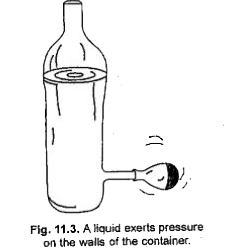Perform an experiment to show that liquid exerts pressure on the walls of the container.
Text Solution
Object : To show that a liquid exerts pressure on the walls of the container.
Material Required : A plastic bottle, a cylinderical glass tube, water, wax, a thin rubber sheet.
Procedure :
1. Take a plastic bottle

2. Fix a cylindrical glass tube, a few cm long near its bottom as shown in fig. 11.3.
3. Make sure that the water does not leak from the joint. If there is any leakage, seal it with molten wax.
4. Cover the mouth of the glass tube with a rubber sheet.
5. Now fill the bottle upto half with water.
6. What do you observe? Why does the rubber sheet fixed to the glass tube buldge this time? Pour some more water in the bottle Is there any change in the bulge of the rubber sheet?
It is due to the water pressure in the bottle that the rubber sheet bulges. If some more water is poured in the bottle, the pressure of water increases and the bulge in rubber sheet increases.
Conclusion : A liquid exerts pressure on the walls of the container.
|
Updated on:21/07/2023
Similar Questions
Knowledge Check
- Question 1 - Select One
Gas exerts pressure on the walls of the container because the molecules are –
AColliding with each other and exchanging momenta.BColliding with the walls of the container and transferring energy to the walls.CColliding with the walls and transferring momentum to the walls of the container.DAccelerated towards the walls. - Question 2 - Select One
Assuming the expression for the pressure exerted by the gas on the walls of the container, it can be shown that pressure is
A[13]rdkinetic energy per unit volume of a gasB[23]rdkinetic energy per unit volume of a gasC[34]thkinetic energy per unit volume of a gasD32× kinetic energy per unit volume of a gas - Question 3 - Select One
According to kinetic theory of gases, the pressure exerted by the gas on the walls of the container is measured as
Amomentum imparted to the walls per second per unit areaBmomentum imparted to the walls per unit areaCchange in momentum imparted to the walls per unit areaDmomentum imparted to the walls per second
A gas exerts pressure on the wall of the container. Assign reason.
View SolutionLiquids and gases exert pressure in all directions. They exert pressure on the walls of the container also.
View SolutionCollisions between the molecules of a gas and its container exert pressure on the walls of the container. (T/F)
View SolutionDescribe a simple experiment to demonstrate that a liquid enclosed in a vessel exerts pressure in all directions.
View SolutionThe temperature of a gas is raised while its volume remains constant, the pressure exerted by the gas on the walls of the container increases because its molecules
View Solution

